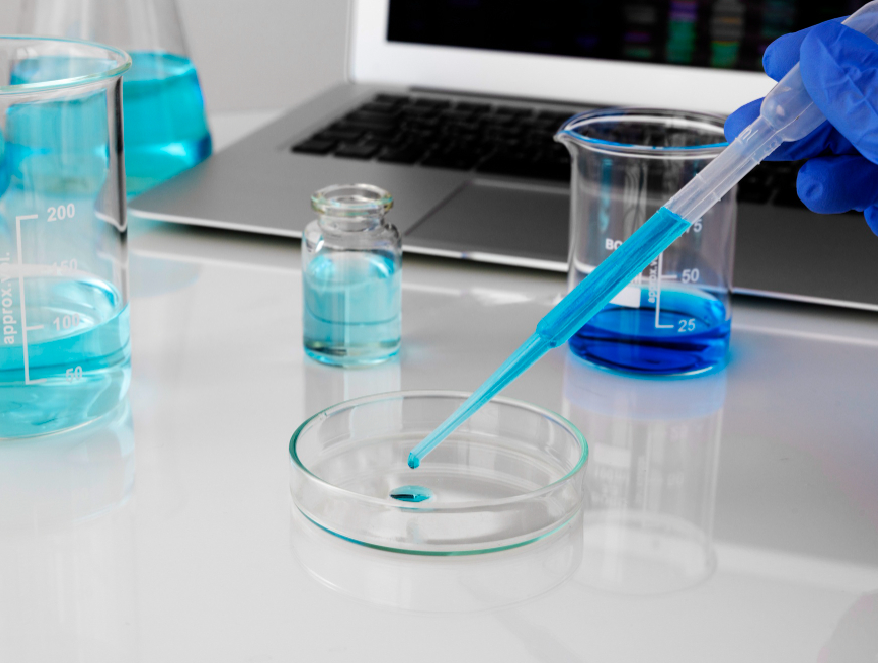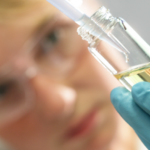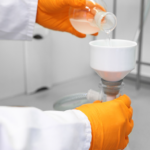Scaling up the manufacture of an API from the discovery lab to a commercial production is a challenging process. It’s not as simple as merely using the same reactions and conditions on a larger scale. The synthetic route used by medicinal chemists is rarely appropriate for scaling up, for a variety of reasons ranging from cost to safety. And this is where the skills and experience of the process chemistry team come into play.
Here at DAPIN in Halle Westphalia, this is one of our key skills. We usually get involved in a project in its early phases, when batches are being made for Phase I and II clinical trials, where kilogram quantities are required. The early discovery work will, of course, have been carried out by the client, and their chemists will have made the molecule in the lab, and may have produced slightly larger quantities on a pilot scale to underpin preclinical work.
If the client has already developed a feasible manufacturing route, the key task of the experts in our process R&D team is to make the manufacturing process fit for scale-up to much larger quantities. A wide range of aspects will need to be closely studied and addressed, as well as how much leeway the customer is willing to give the team – and which, if any, parameters they would prefer to leave unchanged.
Potential hazards
So what topics will the team at DAPIN need to consider for each individual reaction in the synthetic route to make an API? One concerns the reagents and solvents used in the process. Do any pose hazards that might be avoided if an alternative is used? Are there are sourcing issues for any of them? Are any prohibitively expensive, and could they be replaced?
Allied to this cost question is another focusing on raw material quality. Are there any raw material quality requirements that will affect the purity of the final API? Do they need to meet pharmaceutical-grade standards? Is all the necessary documentation provided by the suppliers, such as certificates and statements confirming the absence of nitrosamines, or BSE/TSE contaminants? Have the suppliers been audited, and if not, are they open to inspection?
And there are a range of questions about the reactions and processing conditions. Might a reaction be run at higher concentration to reduce solvent use, and should it be possible to increase batch sizes in the future? Is it possible to optimise reaction temperatures to improve process efficiency, make the process faster and safer, or easier to implement within the production facility?
Keeping track of the reaction’s progress is important, ensuring it is left running for long enough to maximise conversion, but no longer. This will optimise the time taken for the reaction, and may also prevent product breakdown and minimise the potential for the formation of by-products or side products.
Purification and safety
This brings us to purification. How is it purified? Is this appropriate for a large-scale process? And does it efficiently remove any by-products or residual reagents? And for a multi-step synthesis, is it possible to run two or more steps consecutively without isolating and purifying the intermediate and without impacting the quality and yield of the final product?
Safety is always an important consideration – how can we ensure the safety of everyone involved, and meet the requirements of the authorities. This will include determining the enthalpy of the reaction and the adiabatic rise in temperature. All the raw materials, intermediates and the final product will need to be screened to establish their thermal behaviour. Does anything have the potential to be unstable, and are decomposition reactions possible?
Then, there’s waste. How can the process’s waste streams be minimised? Is it possible to recycle and reuse the solvents? Finally, in preparation for the validation of the manufacturing process, a product quality risk analysis is carried out. All the reaction parameters are also examined to determine their proven acceptable ranges.
With all of these answers and data points in hand, the process R&D team at DAPIN will be in a good place to develop a viable and effective process, and one that is ready to implement at a large scale. It is this attention to detail that makes the difference.
AUTHOR
Dr. Rosemarie Bandt
Head of Process R&D

Contact Us
Contact us today to explore reliable, end-to-end API and
Intermediates solutions tailored to your needs.




